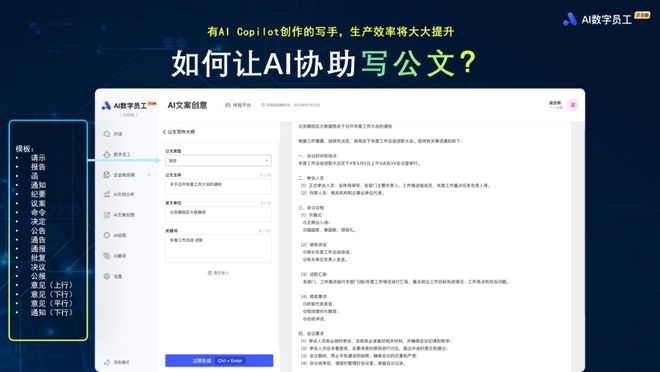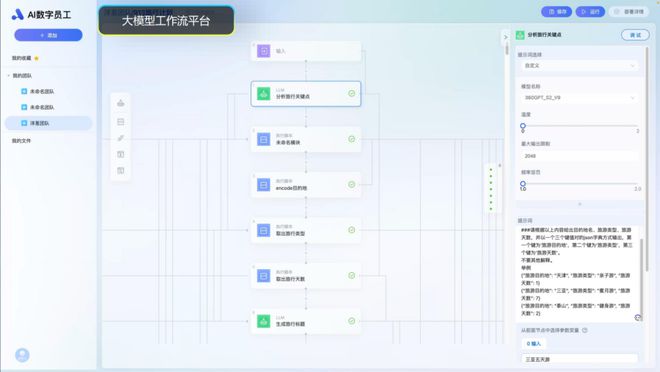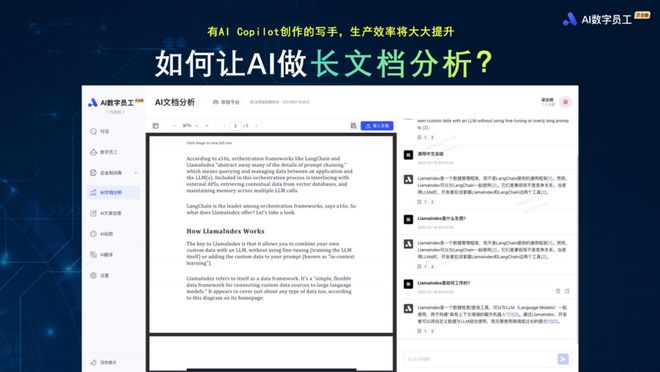How to Build a Smarter 'AI Digital Copywriting Employee'
-
Large language models are making their mark across industries, understanding human language, generating innovative content, and even helping businesses improve efficiency. Regardless of company size, the barrier to adopting AI technology seems increasingly low.
However, behind the rapid iteration lies challenges such as data privacy, interpretability, data ethics, and various technical hurdles.
Perhaps the biggest concern is the word "security", an industry challenge that 360 has been addressing since its inception—only now, it's set against the backdrop of the AI large model era.
After multiple rounds of exploration, 360 proposed a combined strategy of "human + large model knowledge base + AI", ensuring data security while significantly reducing the cost for enterprises to build their own large models. Detailed strategies were discussed in a previous article titled "".
But industry demands go beyond this—not only must it be more secure and cost-effective, but also smarter.
This article serves as a supplement to the latter, focusing on how to build a smarter "AI digital employee."
In technical terms, 360 achieves this by manually designing large model workflows, establishing a knowledge base system, and enabling model hubs and fine-tuning capabilities. Based on foundational capabilities such as task systems, decision chains, reasoning systems, and more, a low-code configuration platform is created, complete with external API integration.
This platform allows administrators and IT personnel within enterprises to use it effectively. They can write not just one prompt but multiple prompts, enabling the large model to function as a Copilot for executing highly complex tasks.
In short, with minimal human intervention, "digital employees" can collaborate effectively.
In practical applications, the powerful capabilities of AI digital employees manifest in two key areas: externally, they can create lifelike, real-time interactive digital personas such as investment ambassadors, virtual speakers, and sales representatives; internally, they provide more efficient digital employee services for enterprises.
Innovations like these continue to surge beneath the surface.
As Liang Zhihui, Vice President of 360 Group and head of N-World, recently mentioned at an event, AI trends are redefining how we work. In the future, we will see more AI applications emerge, tackling greater challenges and becoming powerful partners for humanity.
This is an era brimming with opportunities and potential. Enterprises must stay attuned to AI advancements to remain competitive in this field. To explore how AI can become smarter and more creative, and how it will profoundly impact organizational development, let’s dive into insights and observations from 360’s frontline experience. Below, enjoy:
01 How to Make Large Models Smarter
Large language models excel at three main tasks: content generation, content understanding, and logical reasoning.
If you want to know how to make large models smarter, the first step is to define what "smart" means. In many scenarios, when interacting with GPT, you might notice that it can only respond once to a single instruction, making it difficult to complete highly complex tasks. To address this, 360 has expanded the capabilities of large models by enabling multi-turn dialogues, multimodal interactions, and GOI (Goal-Oriented Interaction) functionalities.
These interaction capabilities have been transformed into a low-code configuration platform, allowing administrators and IT professionals within enterprises to use it effectively. They can now write multiple prompts instead of just one, turning the large model into a Copilot-like assistant capable of executing highly complex tasks.
Currently, 360's Digital Employee Platform includes a low-code workflow configuration platform for large models. The general process is as follows:
- Based on existing large model components, manually design workflows to establish a knowledge base system, enabling a model marketplace and fine-tuning pretraining capabilities.
- Leverage underlying capabilities such as task systems, decision chains, reasoning systems, and more to make the model smarter. This allows the model to execute more steps, interact hundreds of times, and even call external APIs.
For internal office use, the 360 team has developed an AI Data Assistant. This assistant can handle multimodal interactions like document analysis and summarization within enterprises.
Here’s a concrete example: Suppose you want the model to plan a trip to Lijiang, Yulong Snow Mountain, and Shangri-La. The model would need to search and execute step-by-step, identifying attractions, local customs, activities, and hotels.
The model can generate a highly professional 100-step travel plan, producing workflow results that include cultural customs, attraction introductions, and environmental details, all formatted into a table and compiled into a professional report.
This demonstrates that large models can handle extremely complex tasks. Today, they can execute 100 steps, and soon, they may handle 1,000 or even 10,000 steps.
In large model applications, enabling multiple models or intelligent systems to collaborate is crucial. This feature is already available in 360's AI Brain and AI Digital Employee platforms.
In this process, you only need to give a single command to have several AI digital employees complete all the work. Additionally, AI can write content with distinct styles, such as modern bureaucratic documents, weekly reports, and daily logs.
Many office workers can relate to this. Often, you need to write with a certain structure and tone, and using GPT or other large language models yields the best results.

Here, 360AI can summarize articles and work reports, and even draft official documents, requests, reports, letters, and notices. While manual writing might produce 2,000 characters per hour, with AI assistance, it’s possible to generate 20,000 or even 40,000 characters in the same time.

The drawing function is also crucial. In daily operations, companies often need design images for marketing content. Recently, 360 launched the LoRA360 Platform, allowing users to create AI-generated images based on pre-trained LoRA models, which is highly effective for content analysis.

Financial statement analysis using AI is a common practice among businesses. What used to take 5–6 hours manually can now be done much faster. Similarly, reading and comprehending a research paper, which might have taken 2–3 days, is now more efficient.
Today, you don’t even need to upload a PDF separately to query information from it. Moreover, internal company knowledge and content can be imported into a corporate knowledge base for lightweight training of large models.

The difference lies in the time required: fine-tuning a large model for pre-training might take one to two months, while simple fine-tuning could be completed in about a week.
Now, factual information can be taught to large models through knowledge bases, enabling quick retrieval of relevant data. In reality, much of a company’s internal knowledge exists in document form. By training these documents into AI digital employees, large models can quickly learn and adapt.
02 Challenges and Opportunities in the Era of Large Models
In the process of enterprises adopting public large models for practical applications, there are three main issues:
First, during interactions with large models, there's a risk of exposing corporate secrets, code, and business confidential information.
Second, the hallucination problem in large models is severe. A typical manifestation is that models may generate content they don't actually know. For instance, many models lack geographical information - when asked about good restaurants in Beijing, they might list establishments in Hangzhou instead.
Third, enterprises often need to process different types of information separately, requiring isolation between financial team data and business team data. If a large model is allowed to handle all information, proper segmentation becomes impossible.
Three typical problems frequently encountered in enterprise adoption of large models:
-
Many employees struggle with prompt engineering. Training company clerks to write effective prompts requires significant time investment.
-
Most large models, whether public or private, lack industry-specific knowledge. This hallucination problem worsens when tasks like copywriting or marketing content are assigned to those unfamiliar with the company or industry.
-
Daily business problems often can't be solved with a single prompt or interaction. Enterprises frequently need to create industry reports and action plans requiring hundreds or thousands of steps, but current model interactions may break down after just a few exchanges due to token limitations.
360's approach to large model applications focuses on two directions:
- Providing AI technology and efficient digital employee services for internal use
- Developing interactive digital personas for external marketing, including digital customer service, sales representatives, live stream hosts, and celebrity avatars.
Through large model training, these digital personas can serve as customer support, sales assistants, and facilitators for live streaming and training activities.
Digital humans offer two distinct advantages for corporate cost reduction and efficiency improvement:
-
Powerful Intelligence and Optimal Appearance: Digital humans can be driven by just a single photo, and even a 5-minute video can serve as a live broadcast for a digital host. To achieve this, we focus on three key directions:
- Natural Interaction: Moving beyond simple chat interfaces to enable low-latency, face-to-face communication for more natural human-machine interaction.
- Memory and Personality: Equipping digital humans with the ability to remember conversations and avoid the limitations of traditional chatbots.
- Real-Time Learning: Allowing digital humans to search the internet in real-time for information they don’t know, enhancing their utility.
-
Practical Applications: For example, in August, 360 created a digital host by scanning a real presenter, enabling it to see, hear, and speak effectively. This digital human could even interact with lighting systems to optimize the environment.
AI-Powered Perception Layer: By adding an AI perception layer, digital humans can take on roles in tourism, customer service, and sales, equipped with visual, auditory, short-term, and long-term memory capabilities. They can also be cloned in terms of voice, appearance, movements, and thought processes.
Case Studies:
- Government Services: 360 has deployed digital humans in municipal governments to answer investment-related queries using trained policy data.
- Corporate Presentations: Executives unable to attend events can use digital avatars to deliver speeches or presentations, as demonstrated by 360’s use of photos and audio to create a virtual speaker.
Key Questions: In the realm of large-model entrepreneurship, what are the technological and product barriers? Which aspects are most critical, and where do the real challenges lie?
In the end, it was discovered that not only technology and products are important, but the construction of products is also crucial.
AI is a priority for the development of both individuals and businesses. The earlier one embraces AI, the faster they can achieve growth—potentially at a rate ten times higher than others.
